Page 24 of 387
Safety features of your vehicle
23
Front seat
(1) Forward and backward
(2) Seatback angle
(3) Seat cushion height (Driver’s seat)
(4) Lumbar support (Driver’s seat)*
(5) Seat heater*
(6) Headrest
2nd row seat
(7) Seatback folding
(8) Headrest
(9) Armrest
(10) Seat heater*
* if equipped
SEATS
OSL030001
Manual seat
Power seat
*
* *
*
*
Page 27 of 387
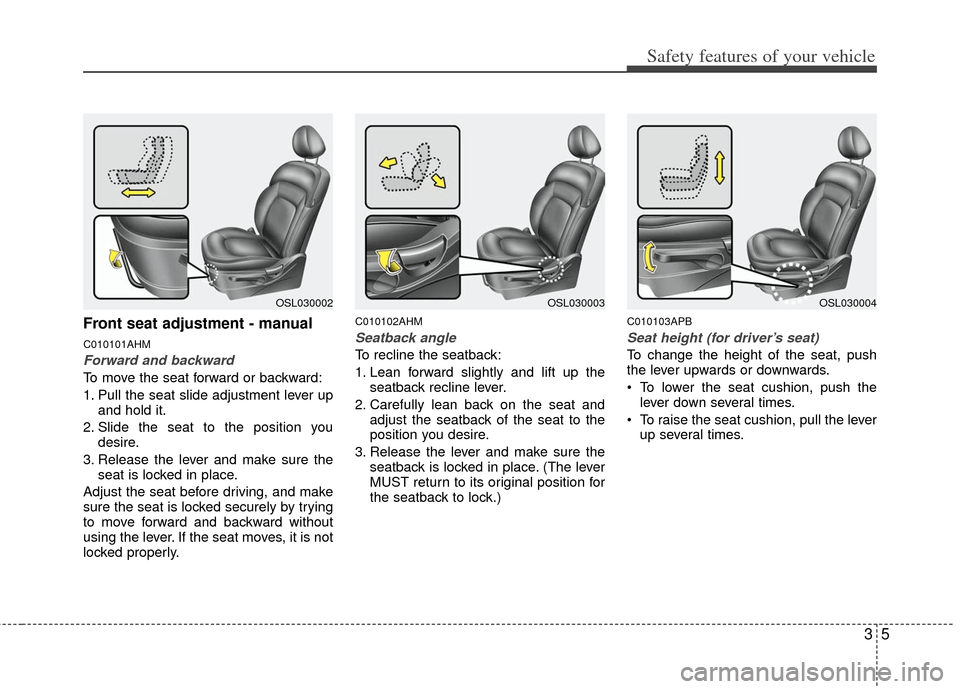
35
Safety features of your vehicle
Front seat adjustment - manual
C010101AHM
Forward and backward
To move the seat forward or backward:
1. Pull the seat slide adjustment lever upand hold it.
2. Slide the seat to the position you desire.
3. Release the lever and make sure the seat is locked in place.
Adjust the seat before driving, and make
sure the seat is locked securely by trying
to move forward and backward without
using the lever. If the seat moves, it is not
locked properly.
C010102AHM
Seatback angle
To recline the seatback:
1. Lean forward slightly and lift up the seatback recline lever.
2. Carefully lean back on the seat and adjust the seatback of the seat to the
position you desire.
3. Release the lever and make sure the seatback is locked in place. (The lever
MUST return to its original position for
the seatback to lock.)
C010103APB
Seat height (for driver’s seat)
To change the height of the seat, push
the lever upwards or downwards.
To lower the seat cushion, push thelever down several times.
To raise the seat cushion, pull the lever up several times.
OSL030002OSL030004OSL030003
Page 29 of 387
37
Safety features of your vehicle
Seatback angle
Push the control switch forward or back-
ward to move the seatback to the desired
angle. Release the switch once the seat
reaches the desired position.
Seat height (for driver’s seat)
Pull the rear portion of the control switch
up to raise or press down to lower the
seat cushion. Release the switch once
the seat reaches the desired position.
Lumbar support (for driver’s seat)
The lumbar support can be adjusted by
pressing the button.
OSL030007OSL030008
OSL030063E
OSL030009
Type A
Type B
Page 30 of 387
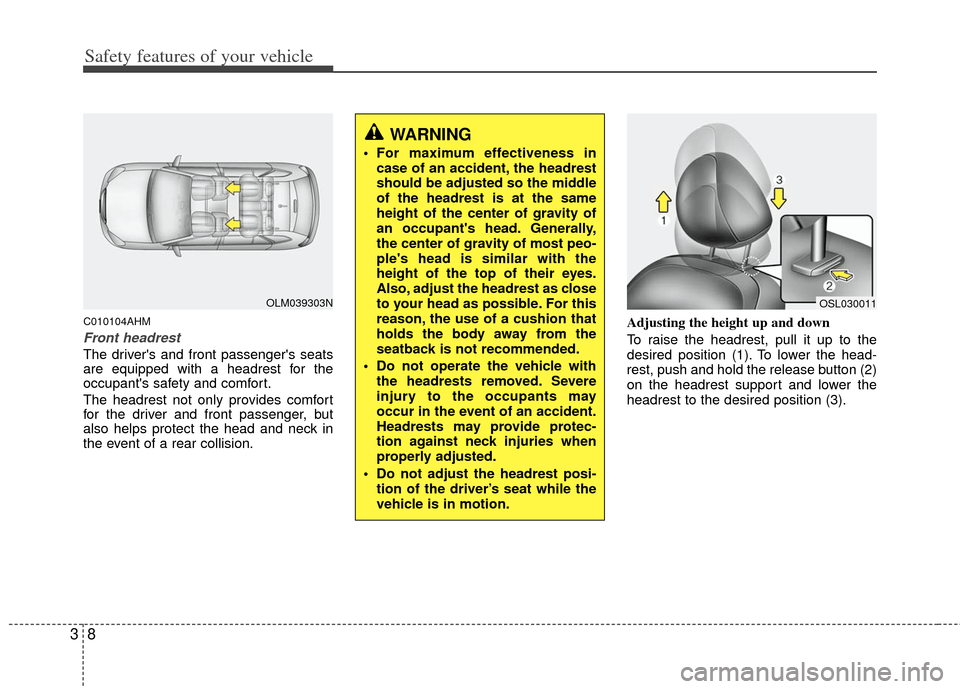
Safety features of your vehicle
83
C010104AHM
Front headrest
The driver's and front passenger's seats
are equipped with a headrest for the
occupant's safety and comfort.
The headrest not only provides comfort
for the driver and front passenger, but
also helps protect the head and neck in
the event of a rear collision.Adjusting the height up and down
To raise the headrest, pull it up to the
desired position (1). To lower the head-
rest, push and hold the release button (2)
on the headrest support and lower the
headrest to the desired position (3).
WARNING
For maximum effectiveness in
case of an accident, the headrest
should be adjusted so the middle
of the headrest is at the same
height of the center of gravity of
an occupant's head. Generally,
the center of gravity of most peo-
ple's head is similar with the
height of the top of their eyes.
Also, adjust the headrest as close
to your head as possible. For this
reason, the use of a cushion that
holds the body away from the
seatback is not recommended.
Do not operate the vehicle with the headrests removed. Severe
injury to the occupants may
occur in the event of an accident.
Headrests may provide protec-
tion against neck injuries when
properly adjusted.
Do not adjust the headrest posi- tion of the driver’s seat while the
vehicle is in motion.
OSL030011OLM039303N
Page 31 of 387
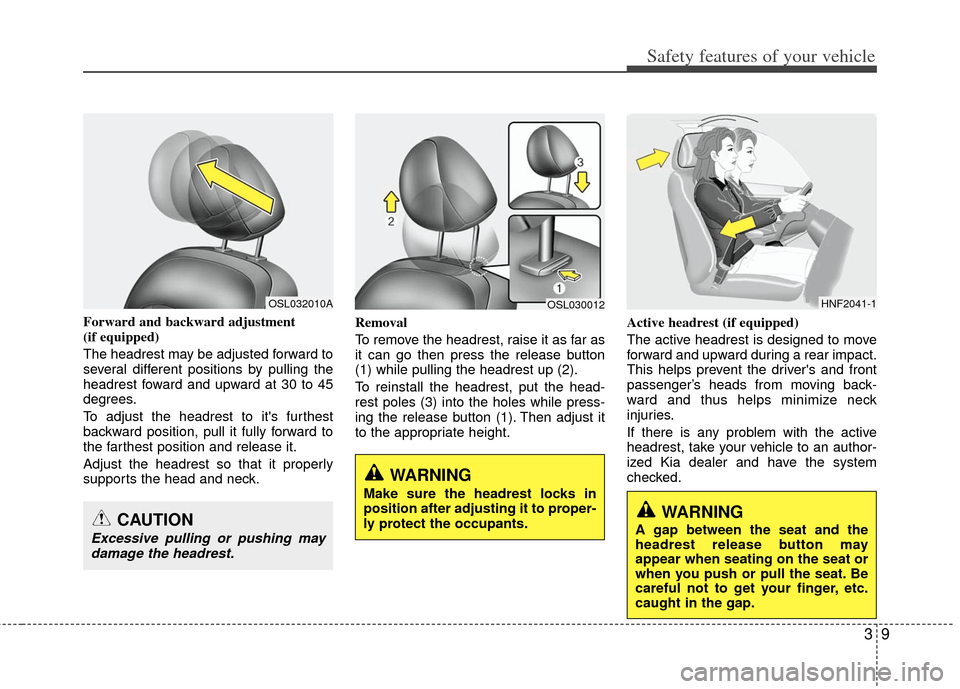
39
Safety features of your vehicle
Forward and backward adjustment
(if equipped)
The headrest may be adjusted forward to
several different positions by pulling the
headrest foward and upward at 30 to 45
degrees.
To adjust the headrest to it's furthest
backward position, pull it fully forward to
the farthest position and release it.
Adjust the headrest so that it properly
supports the head and neck.Removal
To remove the headrest, raise it as far as
it can go then press the release button
(1) while pulling the headrest up (2).
To reinstall the headrest, put the head-
rest poles (3) into the holes while press-
ing the release button (1). Then adjust it
to the appropriate height.
Active headrest (if equipped)
The active headrest is designed to move
forward and upward during a rear impact.
This helps prevent the driver's and front
passenger’s heads from moving back-
ward and thus helps minimize neck
injuries.
If there is any problem with the active
headrest, take your vehicle to an author-
ized Kia dealer and have the system
checked.
CAUTION
Excessive pulling or pushing may
damage the headrest.
WARNING
Make sure the headrest locks in
position after adjusting it to proper-
ly protect the occupants.
HNF2041-1OSL032010AOSL030012
WARNING
A gap between the seat and the
headrest release button may
appear when seating on the seat or
when you push or pull the seat. Be
careful not to get your finger, etc.
caught in the gap.
Page 37 of 387
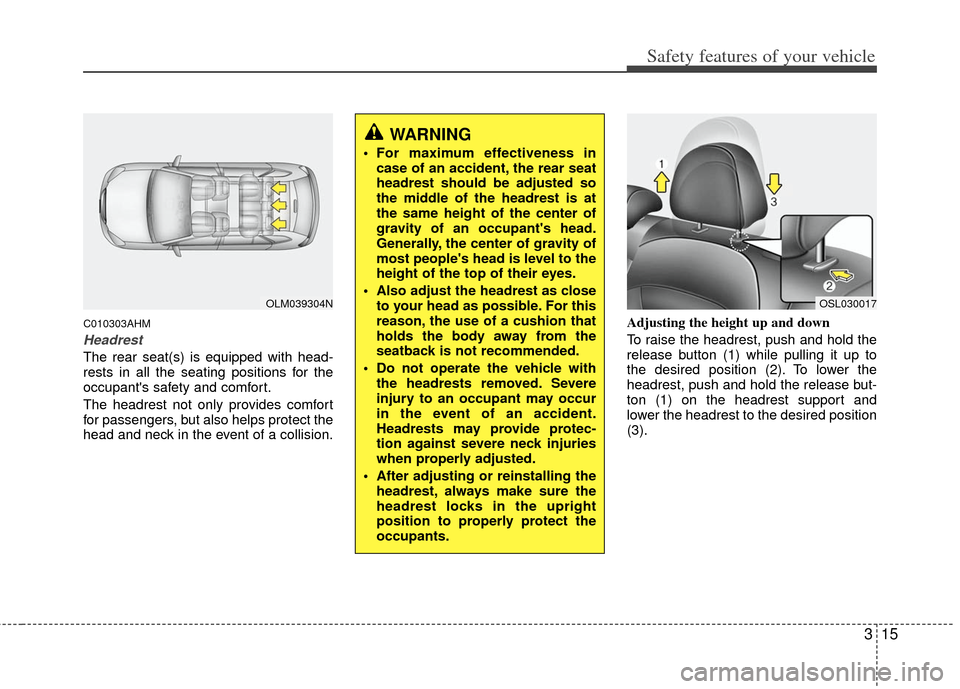
315
Safety features of your vehicle
C010303AHM
Headrest
The rear seat(s) is equipped with head-
rests in all the seating positions for the
occupant's safety and comfort.
The headrest not only provides comfort
for passengers, but also helps protect the
head and neck in the event of a collision.Adjusting the height up and down
To raise the headrest, push and hold the
release button (1) while pulling it up to
the desired position (2). To lower the
headrest, push and hold the release but-
ton (1) on the headrest support and
lower the headrest to the desired position
(3).
OLM039304N
WARNING
For maximum effectiveness in
case of an accident, the rear seat
headrest should be adjusted so
the middle of the headrest is at
the same height of the center of
gravity of an occupant's head.
Generally, the center of gravity of
most people's head is level to the
height of the top of their eyes.
Also adjust the headrest as close to your head as possible. For this
reason, the use of a cushion that
holds the body away from the
seatback is not recommended.
Do not operate the vehicle with the headrests removed. Severe
injury to an occupant may occur
in the event of an accident.
Headrests may provide protec-
tion against severe neck injuries
when properly adjusted.
After adjusting or reinstalling the headrest, always make sure the
headrest locks in the upright
position to properly protect the
occupants.
OSL030017
Page 38 of 387
Safety features of your vehicle
16
3
Removal
To remove the headrest, raise it as far as
it can go then press the release button
(1) while pulling the headrest up (2).
To reinstall the headrest, put the head-
rest poles (3) into the holes while press-
ing the release button (1). Then adjust it
to the appropriate height.Rear seat armrest
To use the armrest, pull it forward from
the seatback.
Rear seat heater (if equipped)
The seat heater is provided to warm the
rear seats during cold weather. With the
ignition switch in the ON position, push
either of the switches to warm rear seats.
During mild weather or under conditions
where the operation of the seat heater is
not needed, keep the switches in the
"OFF" position.
✽ ✽
NOTICE
With the seat heater switch in ON posi-
tion, the heating system in the seat turns
off or on automatically depending on the
seat temperature.
OSL030018OSL030019OSL030020
Page 43 of 387
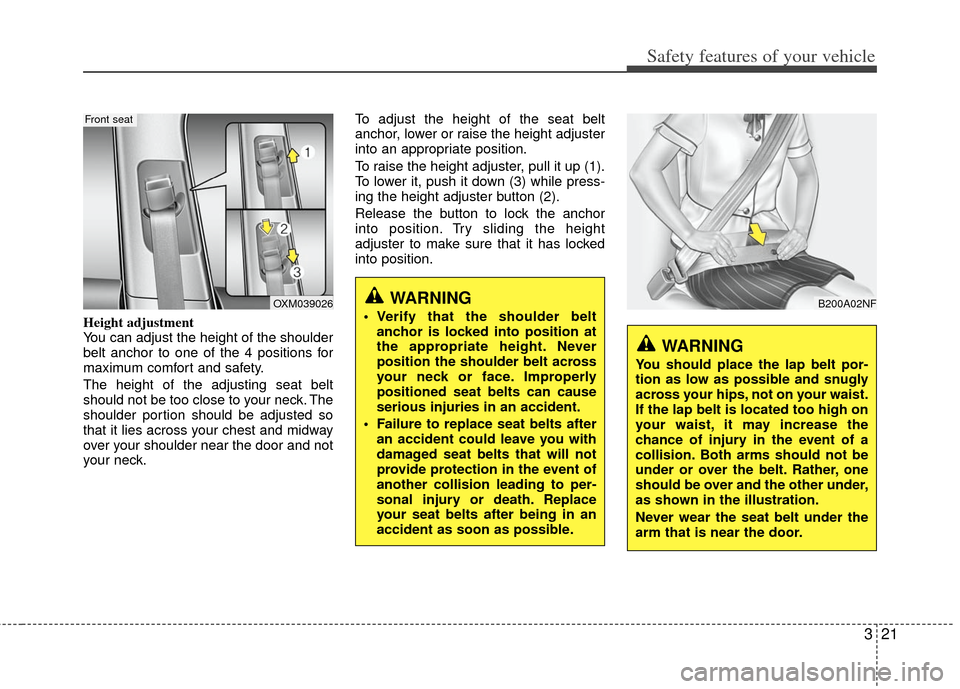
321
Safety features of your vehicle
Height adjustment
You can adjust the height of the shoulder
belt anchor to one of the 4 positions for
maximum comfort and safety.
The height of the adjusting seat belt
should not be too close to your neck. The
shoulder portion should be adjusted so
that it lies across your chest and midway
over your shoulder near the door and not
your neck.To adjust the height of the seat belt
anchor, lower or raise the height adjuster
into an appropriate position.
To raise the height adjuster, pull it up (1).
To lower it, push it down (3) while press-
ing the height adjuster button (2).
Release the button to lock the anchor
into position. Try sliding the height
adjuster to make sure that it has locked
into position.
B200A02NF
WARNING
You should place the lap belt por-
tion as low as possible and snugly
across your hips, not on your waist.
If the lap belt is located too high on
your waist, it may increase the
chance of injury in the event of a
collision. Both arms should not be
under or over the belt. Rather, one
should be over and the other under,
as shown in the illustration.
Never wear the seat belt under the
arm that is near the door.
WARNING
Verify that the shoulder belt
anchor is locked into position at
the appropriate height. Never
position the shoulder belt across
your neck or face. Improperly
positioned seat belts can cause
serious injuries in an accident.
Failure to replace seat belts after an accident could leave you with
damaged seat belts that will not
provide protection in the event of
another collision leading to per-
sonal injury or death. Replace
your seat belts after being in an
accident as soon as possible.OXM039026
Front seat